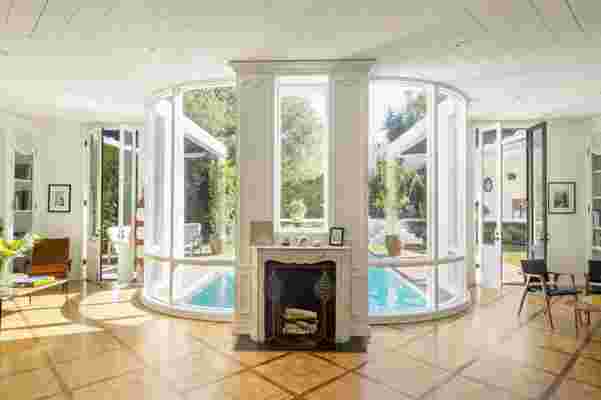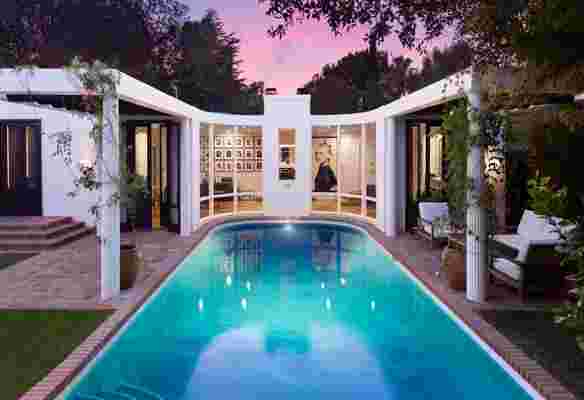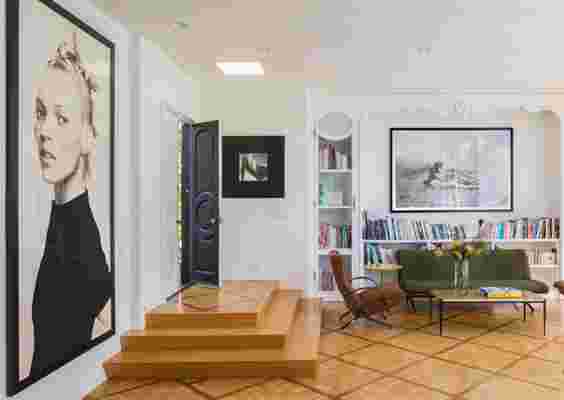Step Inside the Dreamy L.A. Home of Francesco and Bee Carrozzini
Despite its relatively modest scale, the landmark John Elgin Woolf house that is the Los Angeles home of director Francesco Carrozzini and his wife, producer Bee Carrozzini, packs a powerfully alluring punch. Built between 1939 and 1942—not coincidentally at the height of Hollywood’s Golden Age—for actor and television editor Robert Seiter, then extensively remodeled and enlarged by Woolf in the 1960s for Dr. Henry Dodge, Jr., the residence neatly encapsulates the romance and theatricality that define the Hollywood Regency style. Woolf, a debonair Southerner who established himself as a social fixture and tastemaker among Tinseltown’s beau monde , was one of the main progenitors of Hollywood Regency—and arguably its greatest maestro—renowned for his artistry in mixing French Neoclassical, Greek Revival, and modernist design idioms into an intoxicating olio redolent of sun-kissed Southern California living, equally gracious and glamorous. His talents garnered a loyal following among Hollywood’s elite, with a client roster that included Cary Grant , Judy Garland, Errol Flynn, Barbara Stanwyck, Loretta Young, and the Ziegfeld singer and comedian Fanny Brice, one of his earliest champions.
“As a European coming to America, there is a dream aspect to Hollywood that I always found very compelling. This house captures that fantasy,” says Carrozzini, the Italian-born son of the late fashion sibyl Franca Sozzani . Carrozzini began his career as a photographer and music video director, working with the likes of Lenny Kravitz , Jay-Z, and Beyoncé. His 2016 documentary about his mother, Franca: Chaos and Creation , marked a turn to filmmaking. He is currently directing The Hanging Sun , an adaptation of Norwegian author Jo Nesbø’s bestselling novel Midnight Sun.
Carrozzini purchased the Seiter/Dodge residence from hotelier Sean MacPherson in 2017, the year before he and Bee were married. Rhapsodizing about Woolf and his circle in The New York Times in 2002, MacPherson wrote, “Woolf homes are grand dames. At first their drama and glamour appear almost frivolous, but on closer inspection one discovers that every detail has been meticulously calculated.” MacPherson further noted that his own Woolf house was “designed as a small palace.”
By the time Carrozzini arrived on the scene, the grand dame was sorely in need of a facelift, and the only intrigue unfolding at the palace was the punished condition of the parquet floors—what he calls “the pièce de résistance of the house”—and the white plaster walls. Nevertheless, its basic layout, architectural flourishes, and abundant charm remained largely intact. The defining feature of the two-bedroom house is its seductive east façade of curvilinear glass walls that cradle the U-shaped form of the pool, an amenity that was added in 1950 and subsequently reimagined by Woolf in its current form as part of the 1960s renovation. The glazed wings extend outdoors into brick-paved porticos that flank the voluptuous pool.



Buy now for unlimited access and all of the benefits that only members get to experience.
After a painstaking restoration of the parquet, Carrozzini turned his attention to the refurbishment of the living room walls and their shapely proscenium-like moldings, which frame library niches, built-in bookcases, and the focal fireplace set dramatically at the vertex of the curved walls. “I spent a month picking the perfect white,” Carrozzini says. “This project was not about making major changes that would affect the integrity of the architecture. It was a true restoration. Every choice had to be the right choice,” the director adds. He also emphasizes the inherent appeal of the cozy ovular bath and modest kitchen—quiet rebukes to the elephantine scale of contemporary luxury construction.
Carrozzini outfitted the house sparingly, deploying period-sensitive furnishings (notably a suite of Osvaldo Borsani seating) in restrained ensembles that defer to the architectural brio of the building. His myriad connections to the worlds of art, fashion, and photography resonate in a collection chockablock with choice pieces by Mario Schifano, Paolo Canevari, Helmut Newton , Richard Avedon , Robert Capa, Thomas Struth, and Man Ray .
“There’s a soul to certain places,” Carrozzini says, surveying the dreamy lair, which is now—thanks to his advocacy—officially listed as a Los Angeles Historic-Cultural Monument. “Even with nothing in it, this house has so much character. Everything I did was to secure its future.”